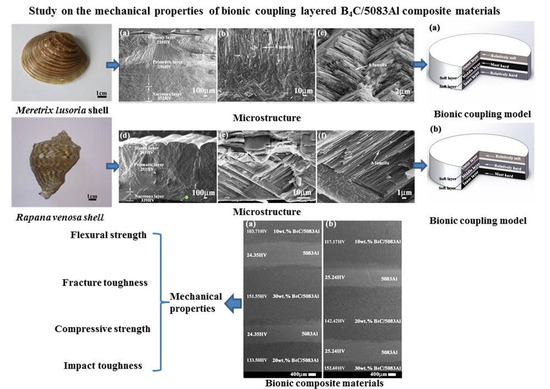Study on the Mechanical Properties of Bionic Coupling Layered B4C/5083Al Composite Materials
Abstract
:1. Introduction
2. Experimental Procedure
2.1. Materials and Fabrication of Bionic Layered Composite Materials
2.2. Metallographic and Mechanical Characteristics
2.2.1. Metallographic Characteristic
2.2.2. Microhardness
2.2.3. Flexural Strength
2.2.4. Fracture Toughness
2.2.5. Compressive Strength
2.2.6. Impact Toughness
3. Result and Discussion
3.1. Microstructure Characteristics of Bionic Models
3.2. Design of Bionic Coupling Model
3.3. Microstructure and Phase Identification of Bionic Layered Composite Materials
3.4. Mechanical Properties of Bionic Layered Composite Materials
3.4.1. Flexural Strength
3.4.2. Fracture Toughness
3.4.3. Compressive Strength
3.4.4. Impact Toughness
4. Conclusions
- (1)
- Meretrix lusoria shell and Rapana venosa shell can be divided into three layers with different hardness. Meretrix lusoria shell and Rapana venosa shell presented the models of “Relatively hard-Most hard-Relatively soft” and “Relatively soft-Relatively hard-Most hard”, respectively, from outer layer to inner layer. The coupling between layered microstructure and hard/soft combination model enhanced the mechanical properties of two shells.
- (2)
- According to characteristics of two shells, two kinds of bionic coupling models were built to guide the design of the bionic layered composites. B4C/5083Al composites with different B4C contents were treated as hard layers. Pure 5083Al was treated as soft layers. Hot pressed sintering maintained advantages of bionic models and realized the transformation from bionic design to bionic fabrication.
- (3)
- The layered structure and different hardness distribution patterns of bionic composites maintained the steady microstructure and phase components of B4C/5083Al composites, proving the validity of bionic coupling models and building material base for realization of high mechanical properties.
- (4)
- Compared with the homogenous B4C/5083Al composites, bionic layered composites exhibited higher flexural strength, fracture toughness, compressive strength and impact resistance. The intercoupling effect of layered structure and hard/soft combination model was the key point for the property of bionic composites. The fabrication of bionic coupling layered composites proved the feasibility and practicability of bionic design and provided a new idea and method for the fabrication of a ceramic/Al composite being lightweight and having a high mechanical strength.
Author Contributions
Funding
Acknowledgments
Conflicts of Interest
References
- Zhang, L.; Wang, Z.; Lia, Q.G.; Wu, J.Y.; Shi, G.P.; Qi, F.F.; Zhou, X. Microtopography and mechanical properties of vacuum hot pressing Al/B4C composites. Ceram. Int. 2018, 44, 3048–3055. [Google Scholar] [CrossRef]
- Xu, Z.G.; Jiang, L.T.; Zhang, Q.; Qiao, J.; Wu, G.H. The microstructure and influence of hot extrusion on tensile properties of (Gd + B4C)/Al composite. J. Alloy. Compd. 2017, 729, 1234–1243. [Google Scholar] [CrossRef]
- Wu, C.; Li, Y.K.; Xie, S.H. Micro-structure, mechanical properties and comparison of monolithic and laminated Ti-B4C composite with Al doped. J. Alloy. Compd. 2018, 733, 1–7. [Google Scholar] [CrossRef]
- Yang, L.Q.; Li, Z.Y.; Zhang, Y.Q.; Wei, S.Z.; Liu, F.Q. Al-TiC in situ composite coating fabricated by low power pulsed laser cladding on AZ91D magnesium alloy. Appl. Surf. Sci. 2018, 435, 1187–1198. [Google Scholar] [CrossRef]
- Krasnowski, M.; Gierlotka, S.; Kulik, T. TiC-Al composites with nanocrystalline matrix produced by consolidation of milled powders. Adv. Powder Technol. 2015, 26, 1269–1272. [Google Scholar] [CrossRef]
- Deng, C.; Xu, B.; Wu, P.; Li, Q.L. Stability of the Al/TiB2 interface and doping effects of Mg/Si. Appl. Surf. Sci. 2017, 425, 639–645. [Google Scholar] [CrossRef]
- Zhao, Q.; Liang, Y.H.; Zhang, Z.H.; Li, X.J.; Ren, L.Q. Effect of Al content on impact resistance behavior of Al-Ti-B4C composite fabricated under air atmosphere. Micron 2016, 91, 11–21. [Google Scholar] [CrossRef] [PubMed]
- Zhu, J.B.; Wang, F.C.; Wang, Y.W.; Zhang, B.W.; Wang, L. Interfacial structure and stability of a co-continuous SiC/Al composite prepared by vacuum-pressure infiltration. Ceram. Int. 2017, 43, 6563–6570. [Google Scholar] [CrossRef]
- Khan, M.; Rehman, A.; Aziz, T.; Shahzad, M.; Naveed, K.; Subhani, T. Effect of inter-cavity spacing in friction stir processed Al 5083 composites containing carbon nanotubes and boron carbide particles. J. Mater. Process. Technol. 2018, 253, 72–85. [Google Scholar] [CrossRef]
- Pozdniakov, A.V.; Lotfy, A.; Qadir, A.; Shalaby, E.; Khomutov, M.G.; Churyumov, A.Y.; Zolotorevskiy, V.S. Development of Al-5Cu/B4C composites with low coefficient of thermal expansion for automotive application. Mater. Sci. Eng. A 2017, 688, 1–8. [Google Scholar] [CrossRef]
- Ambigai, R.; Prabhu, S. Optimization of friction and wear behaviour of Al-Si3N4 nano composite and Al-Gr-Si3N4 hybrid composite under dry sliding conditions. Trans. Nonferrous Met. Soc. 2017, 27, 986–997. [Google Scholar] [CrossRef]
- Vázquez, E.T.; Canul, M.I.P.; Telloa, J.C.G.; Canul, M.A.P. Surface chemistry modification for elimination of hydrophilic Al4C3 in B4C/Al composites. Mater. Des. 2016, 89, 94–101. [Google Scholar] [CrossRef]
- Chen, H.S.; Wang, W.X.; Nie, H.H.; Zhou, J.; Li, Y.L.; Liu, R.F.; Zhang, Y.Y.; Zhang, P. Microstructure evolution and mechanical properties of B4C/6061Al neutron absorber composite sheets fabricated by powder metallurgy. J. Alloy. Compd. 2018, 730, 342–351. [Google Scholar] [CrossRef]
- Yue, X.Y.; Cai, Z.X.; Lü, X.L.; Wang, J.J.; Ru, H.Q. Effect of Ni content on microstructures and mechanical properties of hot-pressed TiC-TiB2-Ni composite. Mater. Sci. Eng. A 2016, 668, 208–214. [Google Scholar] [CrossRef]
- Liu, Z.W.; Rakita, M.; Xu, W.; Wang, X.M.; Han, Q.Y. Ultrasound assisted combustion synthesis of TiC in Al-Ti-C system. Ultrason. Sonochem. 2015, 27, 631–637. [Google Scholar] [CrossRef] [PubMed]
- Liang, Y.H.; Zhao, Q.; Li, X.J.; Zhang, Z.H.; Ren, L.Q. Effect of Ti and C particle sizes on reaction behavior of thermal explosion reaction of Cu-Ti-C system under Ar and air atmospheres. J. Alloy. Compd. 2016, 679, 65–73. [Google Scholar] [CrossRef]
- Pradhan, S.K.; Chatterjee, S.; Das, A.B.M.D. A simple stir casting technique for the preparation of in situ Fe-aluminides reinforced Al-matrix composites. Perspect. Sci. 2016, 8, 529–532. [Google Scholar] [CrossRef]
- Zhou, Z.S.; Wu, G.H.; Jiang, L.T.; Xu, Z.G. The deformation of B4C particle in the B4C/2024Al composites after high velocity impact. Micron 2014, 67, 107–111. [Google Scholar] [CrossRef] [PubMed]
- Zhao, Q.; Liang, Y.H.; Zhang, Z.H.; Li, X.J.; Ren, L.Q. Microstructure and dry-sliding wear behavior of B4C ceramic particulate reinforced Al 5083 matrix composite. Metals 2016, 6, 227. [Google Scholar] [CrossRef]
- Salinas, C.; Kisailus, D. Fracture mitigation strategies in gastropod shells. JOM 2013, 65, 473–480. [Google Scholar] [CrossRef]
- Chen, P.Y.; Lin, A.Y.M.; Meyers, J.M.M.A. Structure and mechanical properties of crab exoskeletons. Acta Biomater. 2008, 4, 587–596. [Google Scholar] [CrossRef] [PubMed]
- Seki, Y.; Schneider, M.S.; Meyers, M.A. Structure and mechanical behavior of a toucan beak. Acta Mater. 2005, 53, 5281–5296. [Google Scholar] [CrossRef]
- Liang, Y.H.; Zhao, Q.; Li, X.J.; Zhang, Z.H.; Ren, L.Q. Study of the microstructure and mechanical properties of white clam shell. Micron 2016, 87, 10–17. [Google Scholar] [CrossRef] [PubMed]
- Zhao, Q.; Liang, Y.H.; Zhang, Z.H.; Li, X.J.; Ren, L.Q. Study on the impact resistance of bionic layered composite of TiC-TiB2/Al from Al-Ti-B4C system. Materials 2016, 9, 708. [Google Scholar] [CrossRef] [PubMed]
- Zhou, Y.; Lei, T.Q. Ceramic Material; Harbin Institute of Technology Press: Harbin, China, 2004; pp. 352–375. (In Chinese) [Google Scholar]
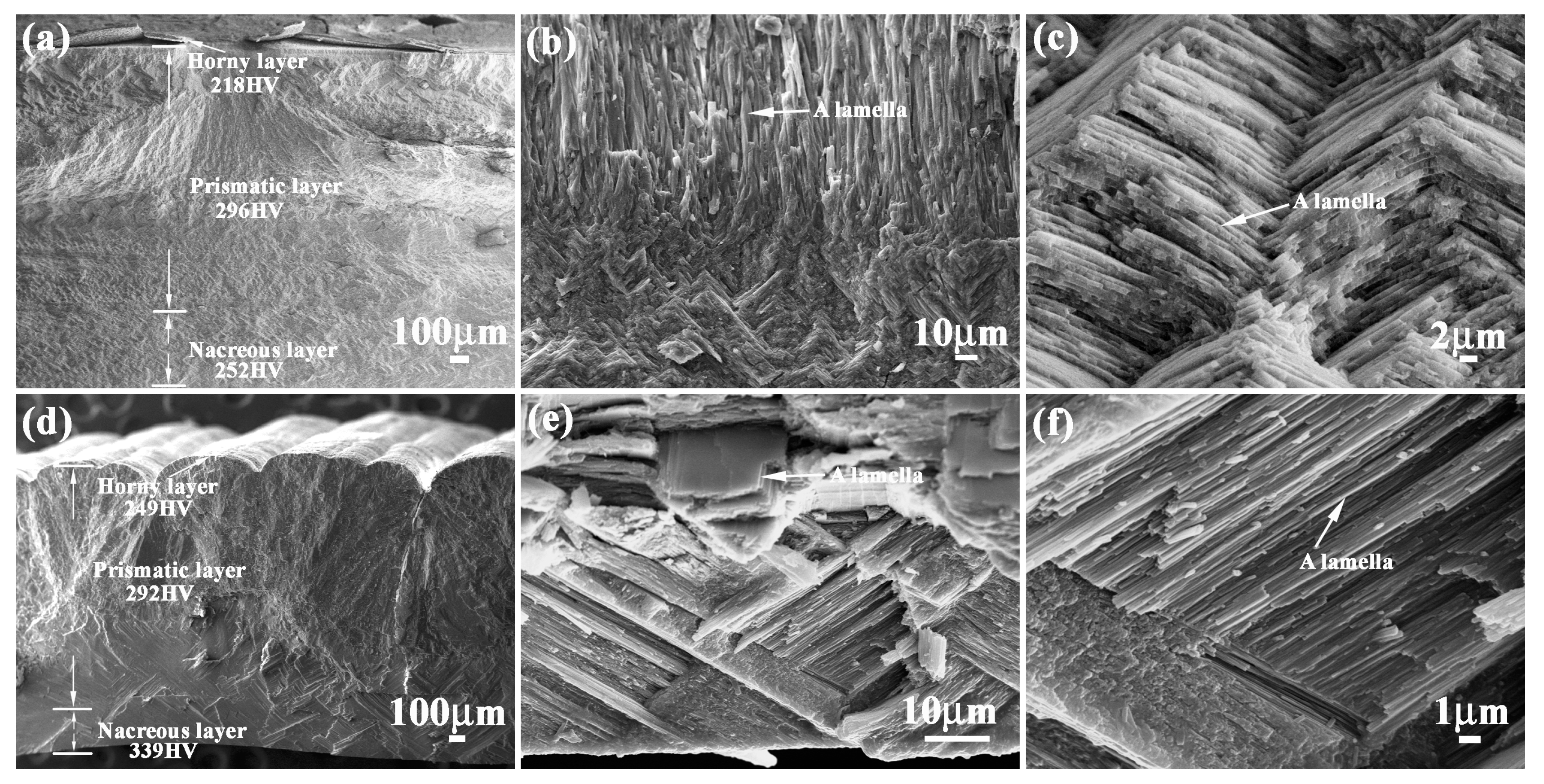
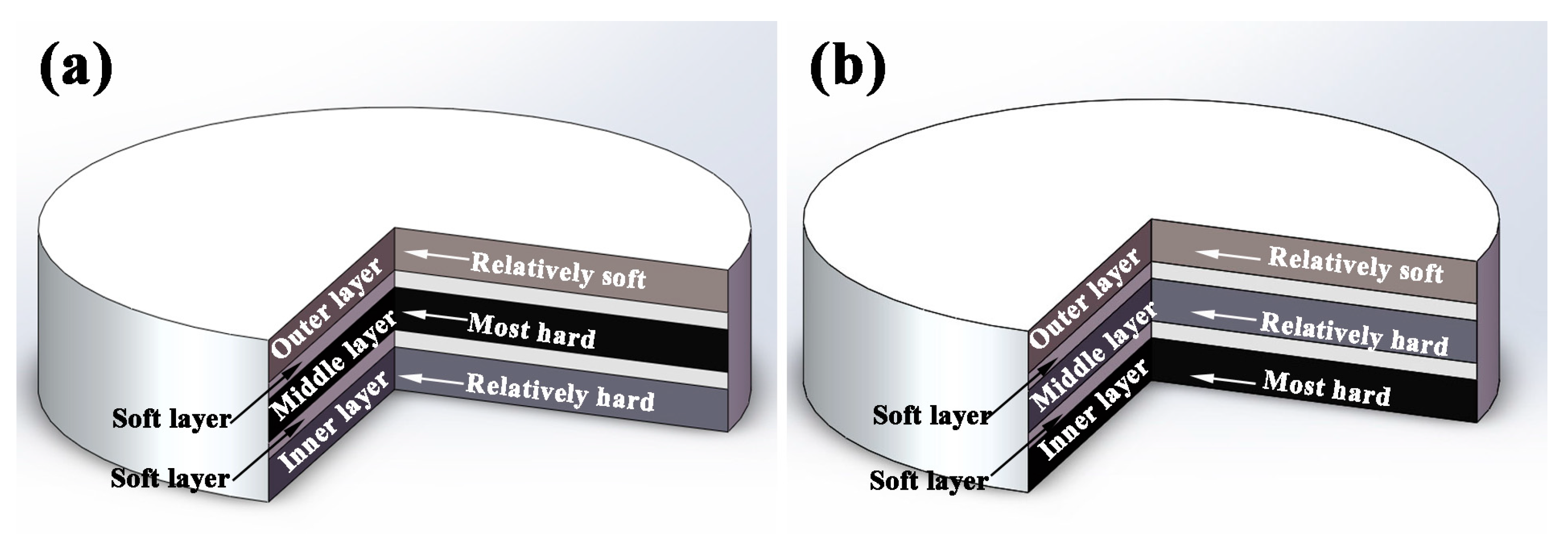
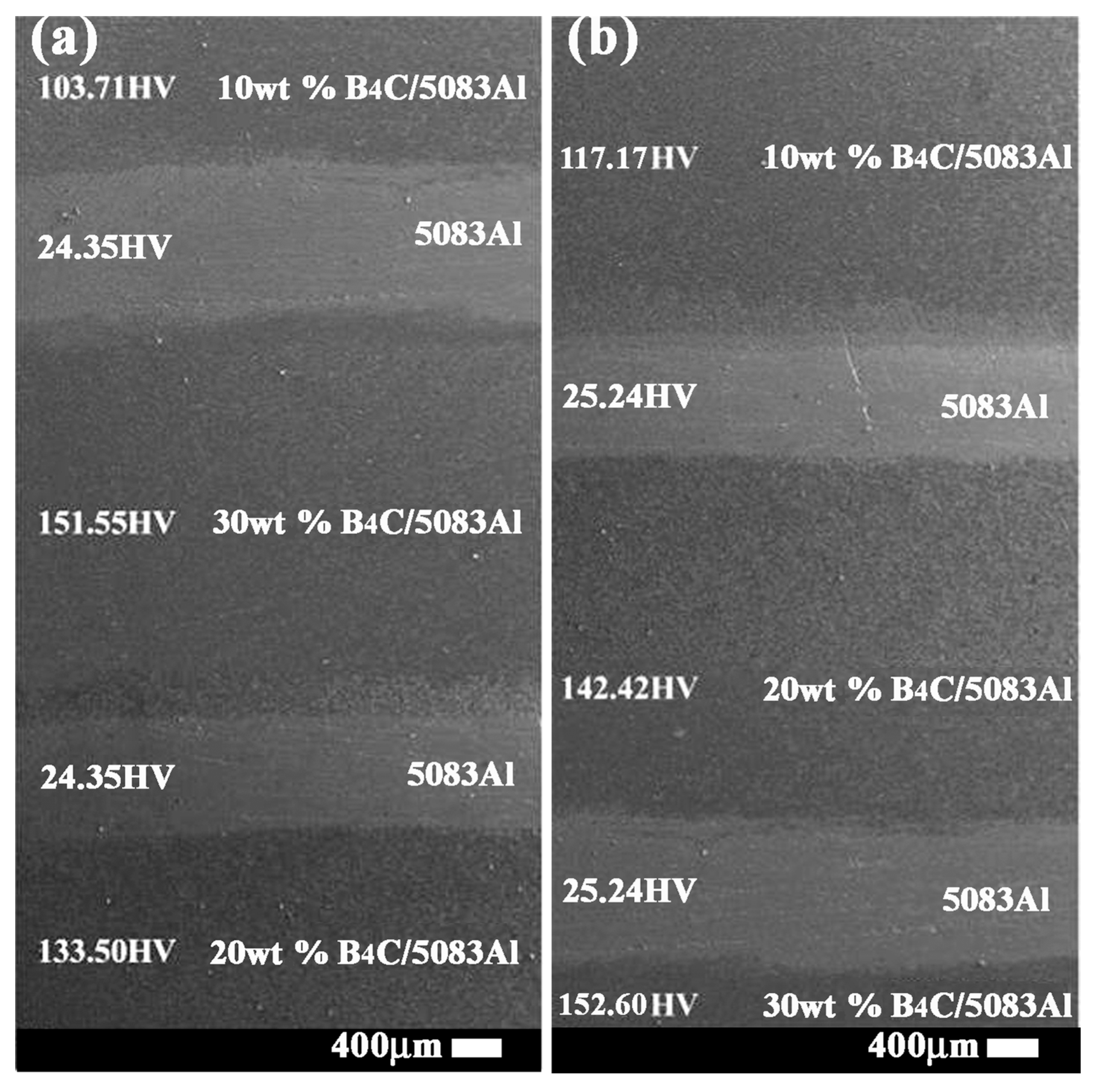


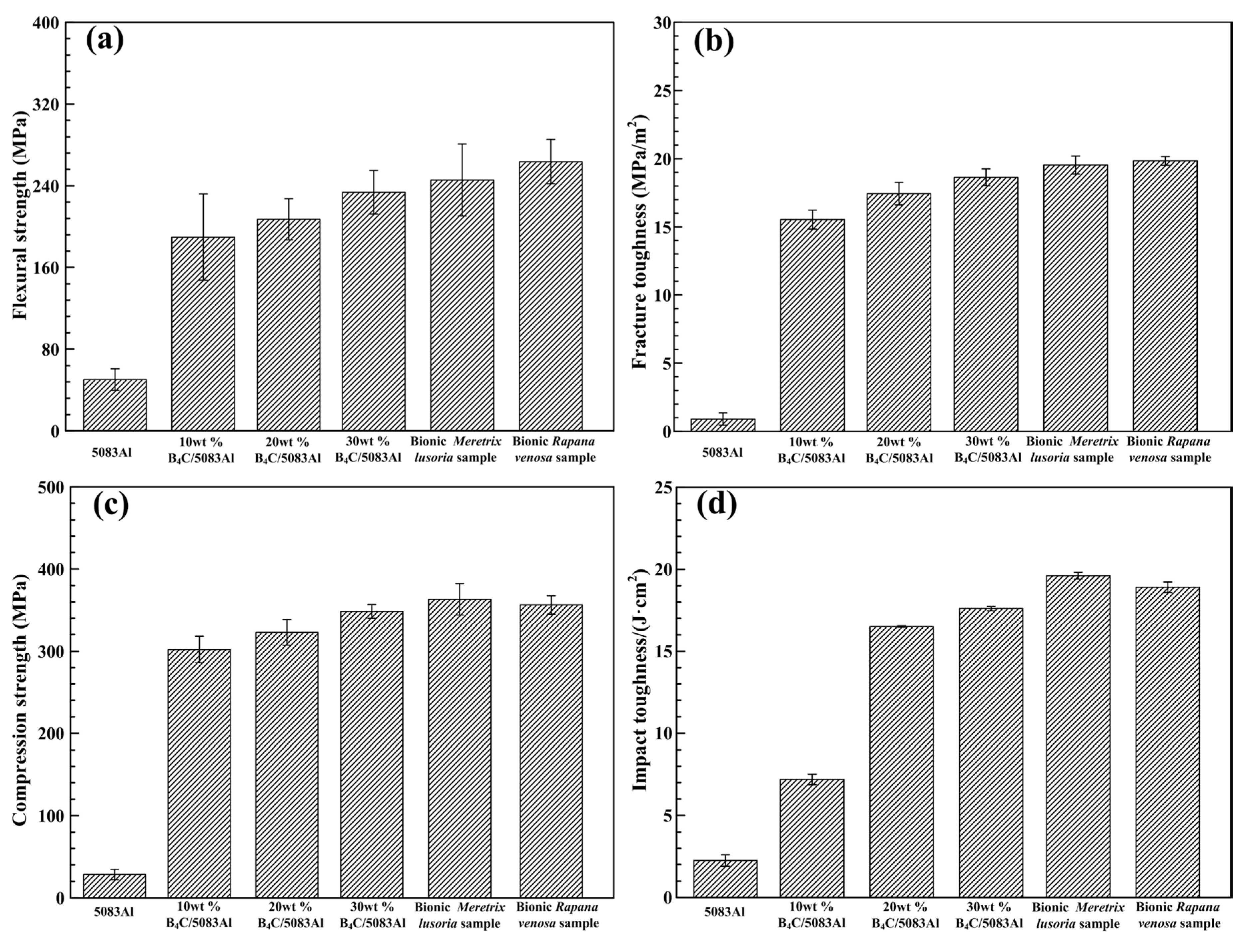
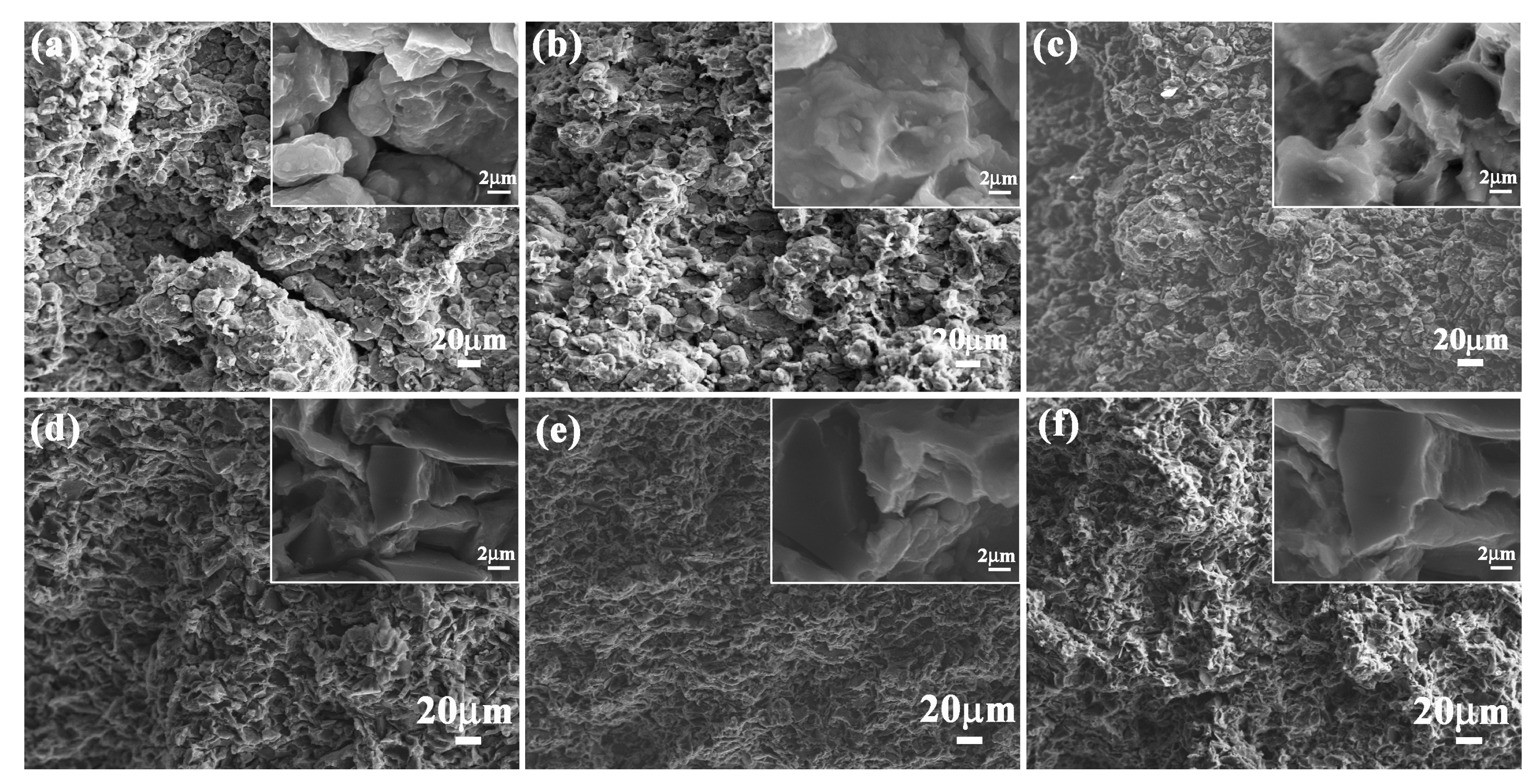
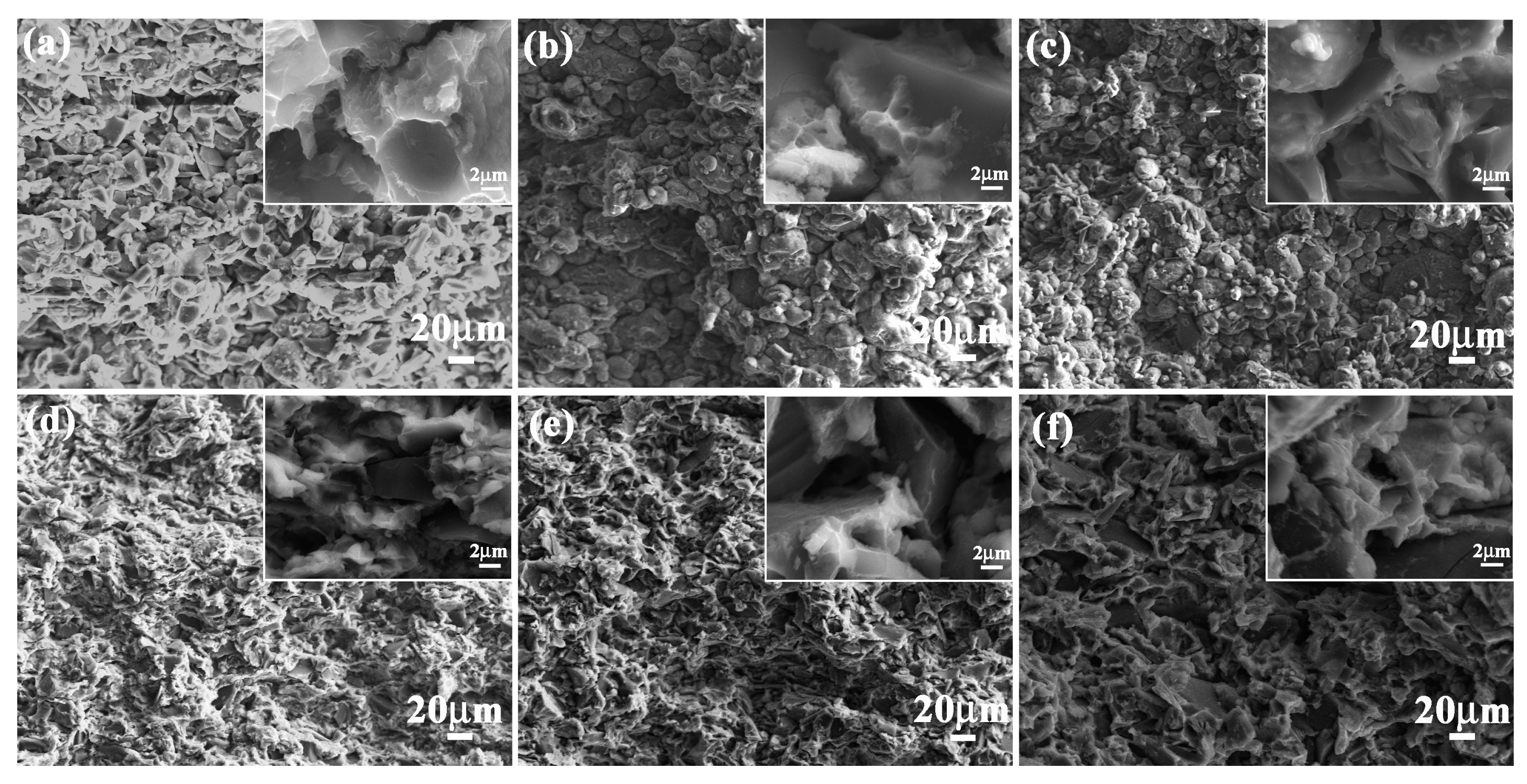
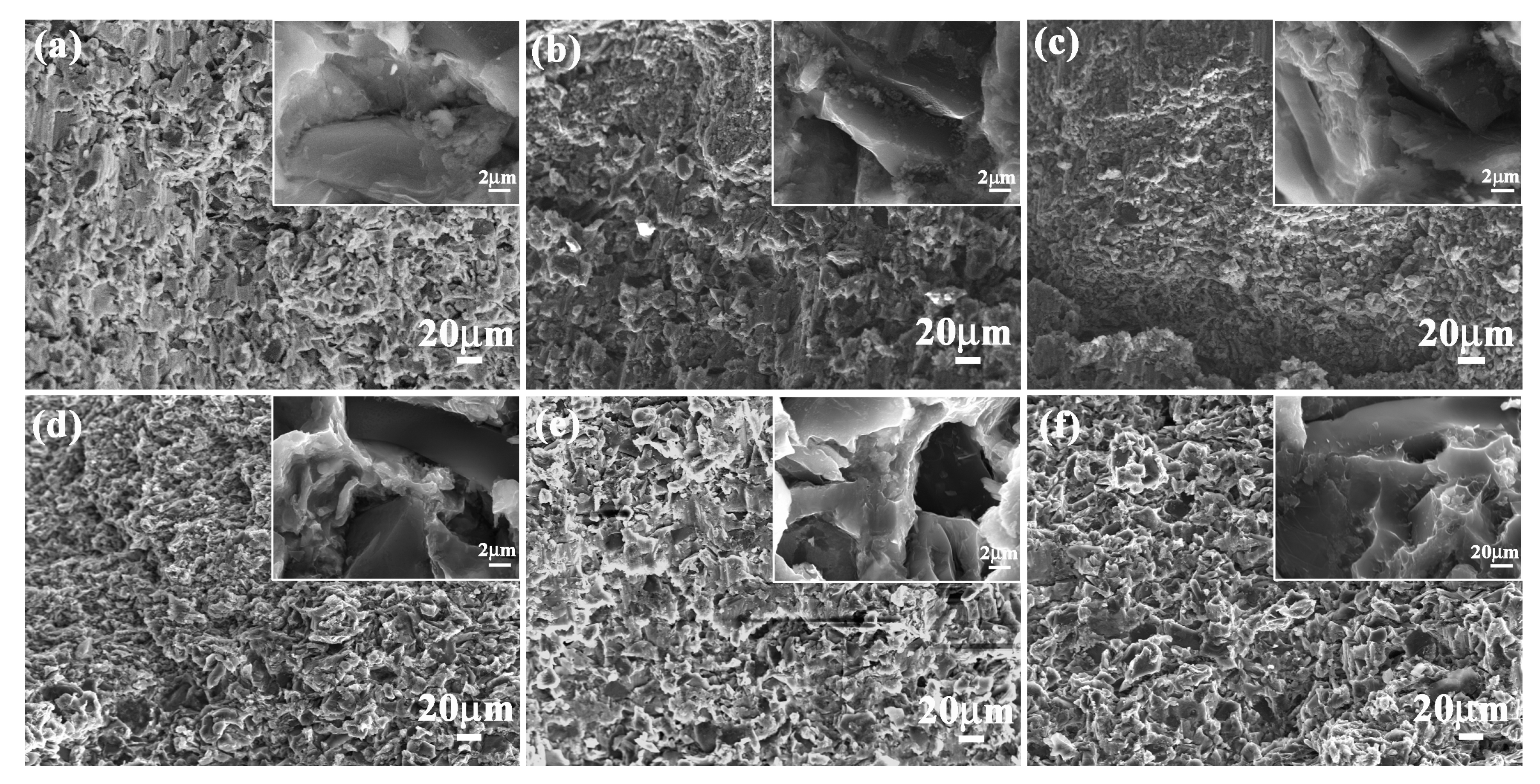
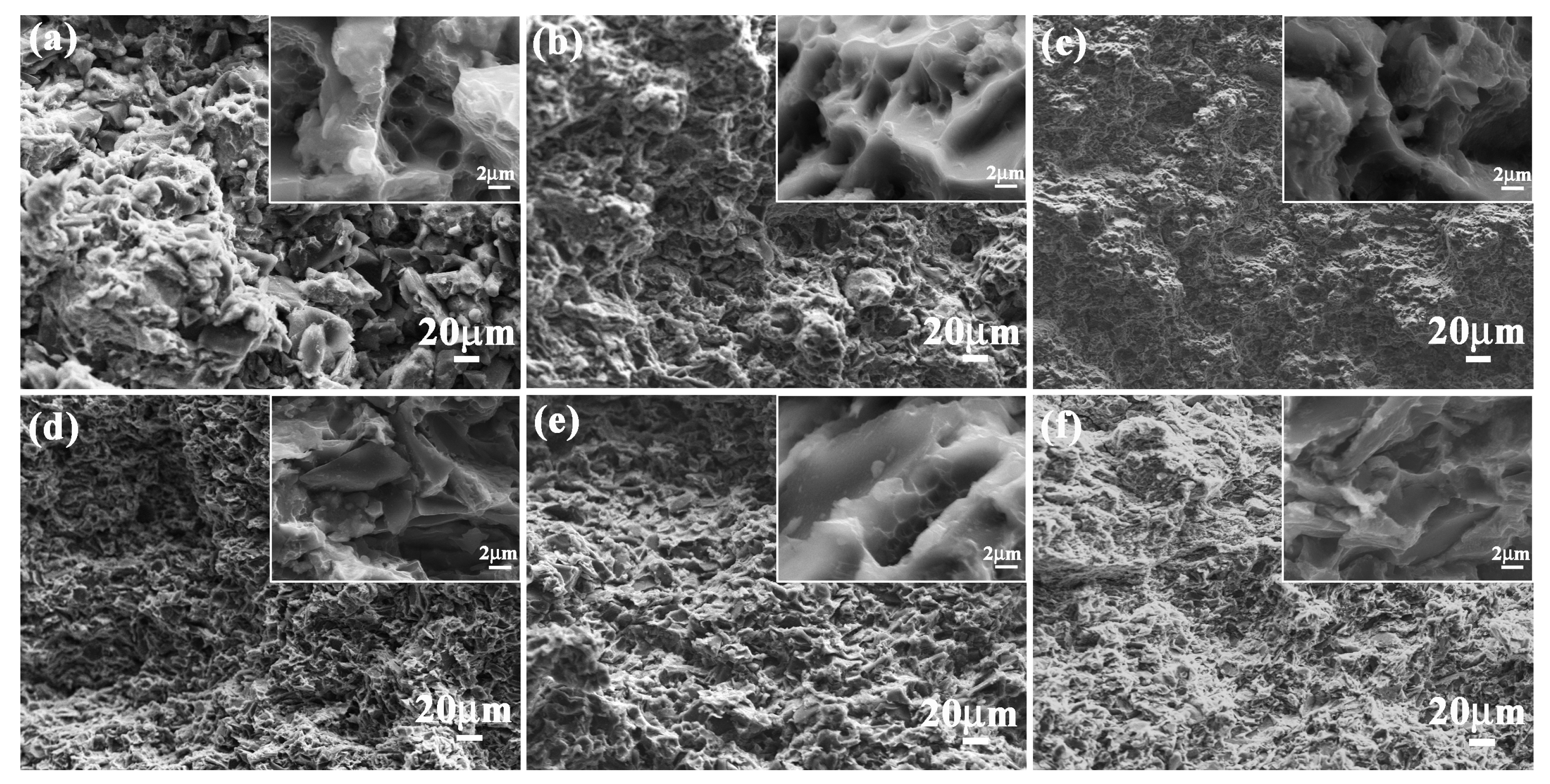
| Loading Mode | A0 | A1 | A2 | A3 | A4 |
|---|---|---|---|---|---|
| Three-point bending (L/h = 4) | 1.93 | −3.07 | 14.53 | −25.11 | 25.80 |
© 2018 by the authors. Licensee MDPI, Basel, Switzerland. This article is an open access article distributed under the terms and conditions of the Creative Commons Attribution (CC BY) license (http://creativecommons.org/licenses/by/4.0/).
Share and Cite
Zhao, Q.; Liang, Y.; Liu, Q.; Zhang, Z.; Yu, Z.; Ren, L. Study on the Mechanical Properties of Bionic Coupling Layered B4C/5083Al Composite Materials. Materials 2018, 11, 680. https://doi.org/10.3390/ma11050680
Zhao Q, Liang Y, Liu Q, Zhang Z, Yu Z, Ren L. Study on the Mechanical Properties of Bionic Coupling Layered B4C/5083Al Composite Materials. Materials. 2018; 11(5):680. https://doi.org/10.3390/ma11050680
Chicago/Turabian StyleZhao, Qian, Yunhong Liang, Qingping Liu, Zhihui Zhang, Zhenglei Yu, and Luquan Ren. 2018. "Study on the Mechanical Properties of Bionic Coupling Layered B4C/5083Al Composite Materials" Materials 11, no. 5: 680. https://doi.org/10.3390/ma11050680
APA StyleZhao, Q., Liang, Y., Liu, Q., Zhang, Z., Yu, Z., & Ren, L. (2018). Study on the Mechanical Properties of Bionic Coupling Layered B4C/5083Al Composite Materials. Materials, 11(5), 680. https://doi.org/10.3390/ma11050680




